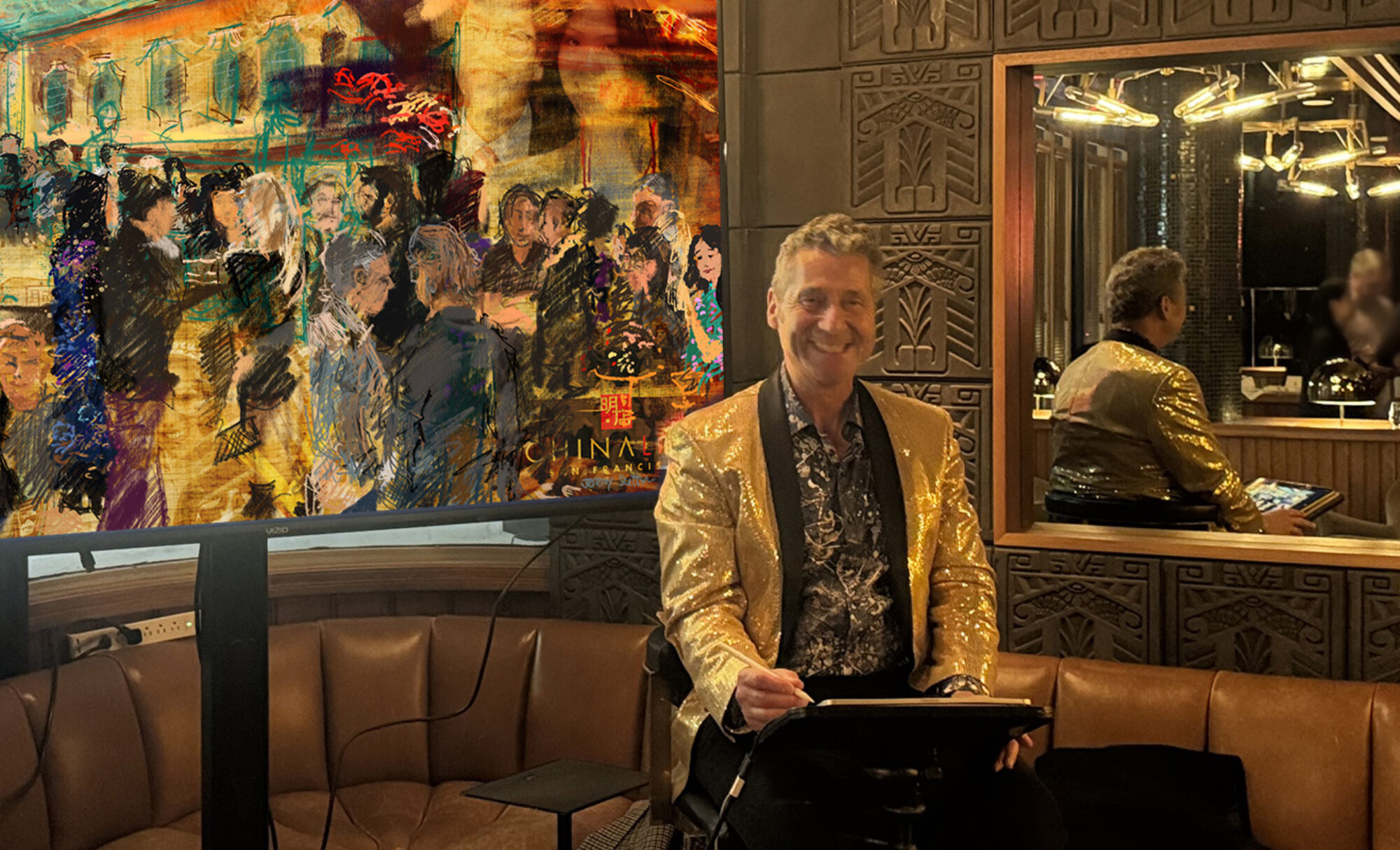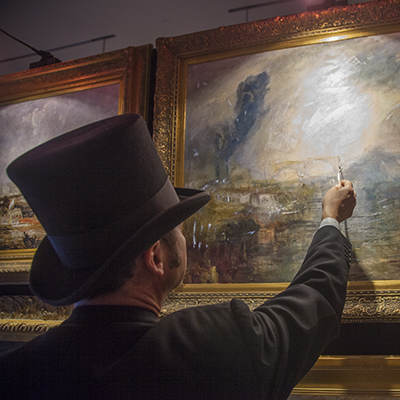
More than any of his colleagues, perhaps, J.M.W. Turner hugely enjoyed and exploited varnishing days, reveling in the sociability, and in the opportunity to paint in a public forum.
– Art on the Line: the Royal Academy Exhibitions in Somerset House 1780 – 1836 (editor David H Solkin).
My Tableau Vivant performance of British artist Joseph Mallord William (“J.M.W.”) Turner pays homage to his love of live painting in the closing moments of the Varnishing Day prior to the opening of the Royal Academy Annual Exhibition held in Somerset House, London (the Academy later moved to its present location at Burlington House). The “Varnishing Day” was actually three days which were allowed for artists to add a touch of varnish to their paintings, or more than a touch in the case of Turner!
My Turner “Varnishing Day” Tableau Vivant performance was part of the de Young Museum’s Musical and Art Exploration Friday Night event, August 14th, 6 – 8:30pm. It took place in the Piazzoni Murals Room. This event celebrated the J.M.W. Turner: Painting Set Free exhibition which is up until September 20th and is well worth seeing. Here are photos and the video slidehow from the “Varnishing Day” tableau vivant performance:








The six paintings I displayed “salon style” in this performance tableau were, clockwise from top left:
 The Opening of Waterloo Bridge (‘Whitehall Stairs, June 18th, 1817’)
The Opening of Waterloo Bridge (‘Whitehall Stairs, June 18th, 1817’)
by John Constable, exhibited 1832
Apparently Constable worked for thirteen years on this painting. A contemporary of Turner (born one year apart) they had an ongoing rivalry throughout their careers, trying to outdo each other at the annual Royal Academy Exhibitions. (more info)
 The Thames above Waterloo Bridge
The Thames above Waterloo Bridge
by J. M. W. Turner, c.1830–5
This painting depicts a rather similar scene to the Constable and makes one wonder if there wasn’t a little one-upmanship involved…
(for more info see Gaurdian article, Telegraph article and the Tate page)
 Rain, Steam, and Speed – The Great Western Railway
Rain, Steam, and Speed – The Great Western Railway
by J. M. W. Turner, 1844
The scene depicts the Maidenhead railway bridge, across the Thames between Taplow and Maidenhead. The bridge, which was begun on Brunel’s design in 1837 and finished in 1839, has two main arches of brick, very wide and flat. The view is to the east, towards London. This painting makes me think of the impact of the industrial revolution on country life, how it shrunk the country and brought the city to the countryside.. (more info)
 Self Portrait
Self Portrait
by J. M. W. Turner, 1799
Painted when Turner was twenty four years old and a rising star. (more info)
.jpg) Going to the Ball (San Martino)
Going to the Ball (San Martino)
by J. M. W. Turner, 1845
This painting was one in the first of two successive pairs of pictures (each depicting Venetian scenes in twilight and dawn going to and from a Ball) created by Turner in response to requests by potential patrons, William Wethered and Francis McCracken. The second pair were created after the first met with derision and rejection. The second set of pictures also drew negative reviews and the patrons got cold feet and ultimately reneged on their commissions. The paintings remained with Turner, unsold and unwanted, until his death. If only Wethered and McCracken could look back now on how much their rejected commissions are valued and lauded…(more info)
 Sir William Chambers, Joseph Wilton and Sir Joshua Reynolds
Sir William Chambers, Joseph Wilton and Sir Joshua Reynolds
by John Francis Rigaud, 1782
This portrait depicts the three leading members of the Royal Academy in 1782, Treasurer, Keeper and President respectively, each foremost in their different fields. Chambers the architect holds a set square and points to an architectural plan, Wilton the sculptor holds a mallet and Reynolds the painter leans on a portfolio which includes an outline representation of Reynolds’s portrait of Chambers which the artist gave to the Royal Academy. (more info)
Two of the three Turner’s I included in my tableau were featured in the J.M.W. Turner: Painting Set Free exhibition in London but did not make it to the American leg of the exhibition tour.
While I was performing, an artist, Jeannie Mecorney, who had attended my iPad Figure Drawing Class at the Mobile Digital Art & Creativity (mDAC) Summit the week before, drew me on her iPad and here are the results which she has kindly permitted me to share:



I was in the Royal Academy Library earlier this summer doing research in preparation for my Turner “Varnishing Day” Tableau, I came across the oil painting by artist Charles West Cope shown here (immediately below).

Painted around 1828, it is the only known image created from life of Turner painting in Somerset House, London, the home of the Royal Academy of Arts during Turner’s life time (the Royal Academy relocated to it’s current location in Burlington House, near Piccadilly Circus, in 1868). The other images at the top of this page show imagined cartoon recreations of Turner on Varnishing Days but are not thought to be drawn from life. According to Cope’s son, this little oil sketch on card made by his father shows Turner demonstrating his skills while acting as a ‘Visitor’ in the Royal Academy Schools, ‘with some of the porters or sweepers looking on’. Though not actually a varnishing day “performance”, it captures the showmanship that Turner brought to painting in front of onlookers. He was an early, if not the first, live event painter!
Big thanks to Peggy for video and photography!




Excellent art!